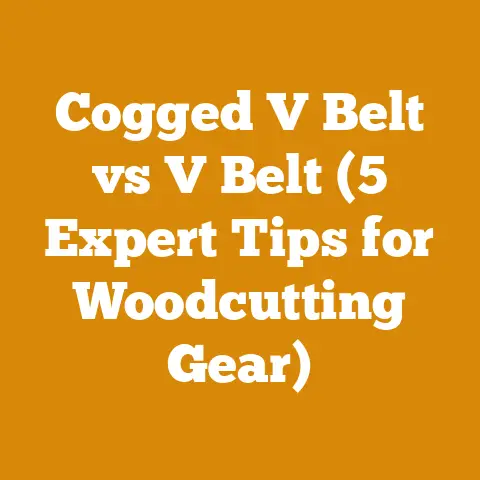Protective Gear for Chainsawing (5 Must-Have PPE Tips)
Introduction: Chainsawing Safely and Sustainably
As someone who’s spent countless hours felling trees, bucking logs, and splitting firewood, I can tell you firsthand: there’s nothing quite like the satisfaction of transforming raw wood into a useful resource. But it’s crucial to remember that chainsawing is inherently dangerous. To me, sustainability isn’t just about responsible forestry; it’s about ensuring you are around to enjoy the fruits (or firewood!) of your labor for years to come. That’s why I’m passionate about proper personal protective equipment (PPE). This guide will walk you through the five essential pieces of PPE every chainsaw operator needs, sharing my experiences and lessons learned along the way. We will explore the best practices I’ve gathered from years in the field.
Protective Gear for Chainsawing: 5 Must-Have PPE Tips
Chainsawing can be a rewarding but dangerous task. To ensure safety, using the right personal protective equipment (PPE) is vital. This guide covers five must-have PPE items for chainsawing, offering practical tips, insights, and best practices to protect yourself effectively.
1. Head Protection: The Unsung Hero
A hard hat is often overlooked, but it’s crucial. I’ve seen firsthand how a falling branch can cause serious injury.
Why a Hard Hat Matters
Hard hats protect against falling branches, debris, and even the chainsaw itself if it kicks back. They are your first line of defense against head trauma.
- Impact Resistance: Look for hard hats that meet ANSI Z89.1 Type I or Type II standards. Type I protects against impacts to the top of the head, while Type II offers protection against lateral impacts as well.
- Material: High-density polyethylene (HDPE) is a common and durable material for hard hats.
- Suspension System: The suspension system inside the hard hat is critical for absorbing impact. Ensure it fits snugly and is adjustable.
- Lifespan: Hard hats have a limited lifespan, typically around 5 years from the date of manufacture, or sooner if they sustain an impact. Check the manufacturer’s recommendations.
My Hard Hat Story
I remember one time, I was felling a large oak. A seemingly small branch, no bigger than my arm, broke off and came hurtling down. It struck my hard hat with a loud thwack. Without that hard hat, I’m convinced I would have suffered a serious concussion.
Real-World Example
A study by the U.S. Forest Service found that head injuries account for approximately 10% of all chainsaw-related injuries. Wearing a hard hat can significantly reduce the severity of these injuries.
Choosing the Right Hard Hat
- Fit: The hard hat should fit snugly but not too tightly. The suspension system should be adjusted to keep the hat stable on your head.
- Ventilation: Consider a hard hat with ventilation to keep you cool and comfortable, especially in hot weather.
- Accessories: Look for hard hats with slots for attaching accessories like earmuffs and face shields.
Best Practices
- Inspect: Always inspect your hard hat before each use for cracks, dents, or other damage.
- Replace: Replace your hard hat immediately if it sustains an impact, even if there is no visible damage.
- Clean: Clean your hard hat regularly with mild soap and water. Avoid using harsh chemicals that can damage the shell.
Statistics
- Approximately 10% of chainsaw-related injuries involve head trauma.
- Wearing a hard hat can reduce the severity of head injuries by up to 80%.
Takeaway
A hard hat is an essential piece of PPE that can protect you from serious head injuries. Always wear one when operating a chainsaw.
2. Eye and Face Protection: Seeing is Believing
Flying wood chips are an unavoidable part of chainsawing. Protecting your eyes and face is paramount.
Why Eye and Face Protection Matters
Eye injuries can range from minor irritations to permanent vision loss. Face shields protect against flying debris, while safety glasses or goggles protect against smaller particles.
- Impact Resistance: Look for eye protection that meets ANSI Z87.1 standards. This standard ensures that the lenses can withstand high-impact forces.
- Lens Material: Polycarbonate lenses are lightweight, durable, and offer excellent impact resistance.
- Coverage: Choose eye protection that provides full coverage of your eyes and the surrounding area.
- Anti-Fog Coating: An anti-fog coating is essential for preventing your lenses from fogging up in humid conditions.
My Eye Protection Experience
I once had a wood chip fly directly into my safety glasses. The impact was significant, and without the glasses, I would have almost certainly lost vision in that eye. It was a stark reminder of how important eye protection is.
Real-World Example
A study by the National Institute for Occupational Safety and Health (NIOSH) found that eye injuries are a common occurrence in the logging industry, accounting for approximately 5% of all injuries.
Types of Eye and Face Protection
- Safety Glasses: Provide basic protection against flying debris.
- Safety Goggles: Offer a tighter seal around the eyes for better protection against dust and small particles.
- Face Shields: Provide full-face protection against larger debris and are often used in conjunction with safety glasses or goggles.
Choosing the Right Eye and Face Protection
- Fit: Ensure that your eye protection fits comfortably and securely.
- Compatibility: Make sure that your eye protection is compatible with your other PPE, such as your hard hat and earmuffs.
- Visibility: Choose eye protection with clear lenses for optimal visibility in all lighting conditions. Tinted lenses may be appropriate for bright sunlight.
Best Practices
- Inspect: Always inspect your eye protection before each use for scratches, cracks, or other damage.
- Clean: Clean your eye protection regularly with a mild soap and water. Avoid using harsh chemicals that can damage the lenses.
- Replace: Replace your eye protection if it sustains an impact or becomes damaged.
Statistics
- Eye injuries account for approximately 5% of all injuries in the logging industry.
- Wearing appropriate eye protection can reduce the risk of eye injuries by up to 90%.
Takeaway
Protecting your eyes and face is crucial when operating a chainsaw. Always wear appropriate eye protection, such as safety glasses, goggles, or a face shield.
3. Hearing Protection: A Sound Investment
Prolonged exposure to chainsaw noise can cause permanent hearing loss. Don’t underestimate the importance of hearing protection.
Why Hearing Protection Matters
Chainsaws typically generate noise levels of 100 decibels (dB) or higher. Prolonged exposure to these levels can lead to noise-induced hearing loss (NIHL).
- Noise Reduction Rating (NRR): Look for hearing protection with a high NRR. The NRR indicates the amount of noise reduction provided by the hearing protection.
- Types of Hearing Protection: Earmuffs and earplugs are the most common types of hearing protection.
- Comfort: Choose hearing protection that is comfortable to wear for extended periods of time.
My Hearing Protection Regret
I didn’t always wear hearing protection when I first started using a chainsaw. I thought, “It’s just for a few minutes.” Over time, I noticed a slight ringing in my ears, especially after prolonged use. Now, I never operate a chainsaw without hearing protection. I wish I had started sooner.
Real-World Example
According to the Centers for Disease Control and Prevention (CDC), noise-induced hearing loss is a leading cause of preventable hearing loss in the United States.
Types of Hearing Protection
- Earmuffs: Provide excellent noise reduction and are easy to put on and take off.
- Earplugs: Come in a variety of shapes and sizes and can be custom-fitted for optimal comfort and noise reduction.
- Electronic Earmuffs: Allow you to hear ambient sounds while still providing noise reduction.
Choosing the Right Hearing Protection
- NRR: Choose hearing protection with an NRR that is appropriate for the noise levels you will be exposed to. A good rule of thumb is to choose hearing protection with an NRR of at least 25 dB.
- Fit: Ensure that your hearing protection fits properly and creates a tight seal around your ears.
- Comfort: Choose hearing protection that is comfortable to wear for extended periods of time.
Best Practices
- Inspect: Always inspect your hearing protection before each use for damage.
- Clean: Clean your hearing protection regularly with a mild soap and water.
- Replace: Replace your hearing protection if it becomes damaged or worn out.
Statistics
- Chainsaws typically generate noise levels of 100 dB or higher.
- Prolonged exposure to noise levels above 85 dB can lead to noise-induced hearing loss.
- Wearing appropriate hearing protection can reduce the risk of noise-induced hearing loss by up to 90%.
Takeaway
Protecting your hearing is essential when operating a chainsaw. Always wear appropriate hearing protection, such as earmuffs or earplugs.
4. Hand Protection: Gripping Reality
Chainsaws vibrate, and prolonged use can lead to hand-arm vibration syndrome (HAVS). Gloves not only protect against cuts and abrasions but also help dampen vibrations.
Why Hand Protection Matters
Gloves protect your hands from cuts, abrasions, and vibrations. They also provide a better grip on the chainsaw, improving control and reducing the risk of accidents.
- Material: Leather, synthetic leather, and Kevlar are common materials for chainsaw gloves.
- Vibration Dampening: Look for gloves with vibration-dampening padding in the palms and fingers.
- Cut Resistance: Choose gloves with cut-resistant material to protect against chainsaw cuts.
My Glove Lesson
I once tried to save a few bucks by using regular work gloves while chainsawing. After a few hours, my hands were numb and tingling. It was a clear sign of vibration damage. I immediately switched to chainsaw-specific gloves with vibration dampening, and the difference was night and day.
Real-World Example
Hand-arm vibration syndrome (HAVS) is a common occupational disease among chainsaw operators. Symptoms include numbness, tingling, and pain in the fingers and hands.
Types of Chainsaw Gloves
- Leather Gloves: Durable and provide good protection against cuts and abrasions.
- Synthetic Leather Gloves: Offer similar protection to leather gloves but are often more breathable and water-resistant.
- Kevlar Gloves: Provide excellent cut resistance and are often used in high-risk situations.
- Vibration-Dampening Gloves: Designed to reduce the amount of vibration transmitted to the hands and arms.
Choosing the Right Chainsaw Gloves
- Fit: Ensure that your gloves fit snugly but not too tightly. You should be able to move your fingers freely.
- Material: Choose gloves made from a durable and cut-resistant material.
- Vibration Dampening: Look for gloves with vibration-dampening padding in the palms and fingers.
Best Practices
- Inspect: Always inspect your gloves before each use for cuts, tears, or other damage.
- Clean: Clean your gloves regularly with a mild soap and water.
- Replace: Replace your gloves if they become damaged or worn out.
Statistics
- Hand-arm vibration syndrome (HAVS) is a common occupational disease among chainsaw operators.
- Wearing vibration-dampening gloves can reduce the risk of HAVS.
- Gloves can improve grip and control, reducing the risk of chainsaw accidents.
Takeaway
Protecting your hands is crucial when operating a chainsaw. Always wear appropriate chainsaw gloves with vibration-dampening padding and cut resistance.
5. Leg Protection: The Last Line of Defense
Chainsaw chaps or pants are your last line of defense against a chainsaw kickback or accidental contact with your legs.
Why Leg Protection Matters
Chainsaw chaps or pants are designed to stop a moving chainsaw chain upon contact. They are made from multiple layers of ballistic nylon or Kevlar fibers that pull apart and clog the chainsaw’s sprocket, halting the chain.
- Material: Ballistic nylon and Kevlar are common materials for chainsaw chaps and pants.
- Coverage: Choose chaps or pants that provide full coverage of your legs, from the groin to the ankle.
- Fit: Ensure that your chaps or pants fit comfortably and allow for freedom of movement.
My Leg Protection Save
I was bucking a log when the chainsaw kicked back unexpectedly. The chain grazed my leg, but thankfully, I was wearing chainsaw chaps. The chaps instantly stopped the chain, preventing a serious injury. I’m eternally grateful for that piece of PPE.
Real-World Example
Studies have shown that chainsaw chaps and pants can significantly reduce the severity of chainsaw-related leg injuries.
Types of Chainsaw Leg Protection
- Chainsaw Chaps: Worn over regular pants and provide protection to the front of the legs.
- Chainsaw Pants: Designed to be worn as regular pants and provide all-around protection.
Choosing the Right Chainsaw Leg Protection
- Coverage: Choose chaps or pants that provide full coverage of your legs, from the groin to the ankle.
- Fit: Ensure that your chaps or pants fit comfortably and allow for freedom of movement.
- Material: Choose chaps or pants made from a durable and cut-resistant material.
Best Practices
- Inspect: Always inspect your chaps or pants before each use for cuts, tears, or other damage.
- Clean: Clean your chaps or pants regularly with a mild soap and water.
- Replace: Replace your chaps or pants if they sustain a chainsaw cut or become damaged.
Statistics
- Chainsaw chaps and pants can significantly reduce the severity of chainsaw-related leg injuries.
- Wearing chainsaw chaps or pants can reduce the risk of leg injuries by up to 80%.
Takeaway
Protecting your legs is crucial when operating a chainsaw. Always wear appropriate chainsaw chaps or pants.
Additional PPE Considerations
Beyond the five essentials, consider these additions for enhanced safety:
- Steel-toed boots: Protect your feet from falling logs and other hazards.
- First-aid kit: Keep a well-stocked first-aid kit on hand for treating minor injuries.
- Communication device: Carry a cell phone or two-way radio for emergencies.
PPE Maintenance and Storage
Proper maintenance and storage of your PPE are crucial for ensuring its effectiveness and longevity.
Cleaning
- Clean your PPE regularly with a mild soap and water. Avoid using harsh chemicals that can damage the materials.
- Allow your PPE to air dry completely before storing it.
Inspection
- Inspect your PPE before each use for damage, such as cuts, tears, or cracks.
- Replace any damaged PPE immediately.
Storage
- Store your PPE in a clean, dry place away from direct sunlight and extreme temperatures.
- Hang your chainsaw chaps or pants to prevent them from creasing or becoming damaged.
The Importance of Training
No amount of PPE can compensate for a lack of training. Before operating a chainsaw, take a certified chainsaw safety course.
What to Expect in a Chainsaw Safety Course
- Chainsaw operation: Learn the proper techniques for starting, operating, and maintaining a chainsaw.
- Tree felling: Learn how to safely fell trees, including assessing hazards and planning your cuts.
- Bucking and limbing: Learn how to safely buck logs and limb trees.
- PPE: Learn about the importance of PPE and how to properly use and maintain it.
- First aid: Learn basic first-aid techniques for treating chainsaw-related injuries.
Finding a Chainsaw Safety Course
- Local forestry agencies: Contact your local forestry agency for information on chainsaw safety courses in your area.
- Community colleges: Many community colleges offer chainsaw safety courses.
- Private instructors: There are many private instructors who offer chainsaw safety courses.
Conclusion: Safety First, Always
Chainsawing can be a rewarding experience, but it’s essential to prioritize safety. By investing in the right PPE, maintaining it properly, and receiving proper training, you can significantly reduce the risk of injury and enjoy the benefits of working with wood for years to come. Remember, sustainability starts with ensuring your own well-being. Stay safe out there!






